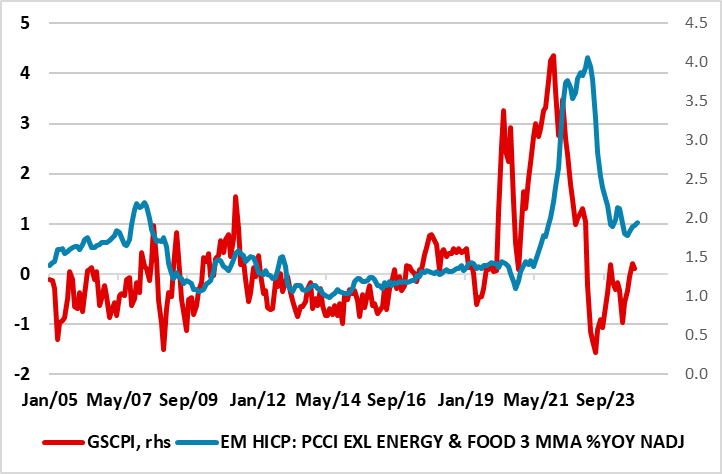ECB Review: Clearly Flagging An End to Policy Restriction
A fourth 25 bp discount rate cut at this latest Council meeting, to 3%, was also the third in a row. But this meeting was important for the (as we expected) change in forward guidance in which the ECB accepts that on-target inflation is likely to be durable enough so that it no longer has to pursue policy restriction. In this regard, the first glimpse of 2027 economic projections support this as they point to a second successive year of around-target inflation even on a core basis and also on the basis of markets assuming rates fall to around 2% in 2026. Amid what has been faster easing, the ECB must be considering what neutral policy and we think the implies around four 25 bp cuts in H1 next year, with an ensuing around-neutral 2% policy rate. But it is possible that amid a continued sub-par growth outlook into 2026, then further easing may be on the cards into 2026.
Figure 1: The ECB’s Revised Outlook in Perspective

Source, Bloomberg, ECB, CE
Gauging Guidance Transition
As we envisaged, this meeting did see a major change in forward guidance. Indeed, and as Chief Economist Lane suggested in an interview last week, this would entail a transition in guidance moving from what hitherto has been backward-looking by being data-dependent to being forward-looking in assessing incoming risks. Admittedly, the ECB as a whole seems reluctant at this juncture to move totally away from being data-dependent, but however much Lagarde suggested otherwise, the Council must be considering what constitutes ‘neutral’. Admittedly, what constitutes neutral varies over time and according to alternative assessments. Notably, according to some ECB hawks, this 25 bp move this month would constitute policy being at least at the upper end of a range of neutral estimates. This contrasts with the more dovish ECB thinking as highlighted by BoF Governor Villeroy who has pointed to a neutral estimate between 2% and 2.5%. And somewhere in the middle there is also thinking that there may have been a bit of an upward movement in this underlying real interest rate but, albeit probably most of it being cyclical, possibly a result of a recent rise in government deficits reducing the saving/investment balance.
But, if so, this may reverse. Indeed, we suggest it is possible that amid a continued sub-par growth outlook into 2026, and where a shift in the savings balance caused by a continued drift higher in precautionary savings alongside uncertainty deterring investment, may ultimately persuade the ECB to revise down its neutral policy assessment. Then this may create scope, if not rationale, for further easing into 2026. In particular, talk, let alone the reality of tariff or non-tariff measures, would be negative for investment and could accentuate precautionary savings motives. In terms of domestic demand, this would be disinflationary and suggest a fall in the neutral policy rate.
Revised Projections and First Sight of 2027 Thinking
But the dominant theme will be the extent to which downside growth risks have turned into reality with it clear that growth worries have risen. Indeed, preserving growth does seem to have become the ECB policy priority, not least against a backdrop of weak business survey data highlighting both fresh stagnation risks and much reduced cost pressures that could even suggest a contraction in GDP this quarter. But the ECB was more open about this, suggesting that the economy “is losing momentum” and that “risks to economic growth remain tilted to the downside as firms are holding back investment spending in the face of weak demand and a highly uncertain outlook.
Admittedly, not all signs are negative. There is the potential boost of the recent build in household savings and the indications that rate cuts have already stared to boost credit demand according to bank lending surveys and even some signs of a recovery on the consumer side, albeit confined to volatile retailing, not services. But the ECB is wary that such signs may yet peter out. And so are markets, hence why rate cuts to below 2% are now discounted over the next year. Given that this still produces an HICP outlook at to just below target, the ECB is largely endorsing such thinking, showing just how much it has been forced to reassess in recent months
Figure 2: 'Most' Measures of Underlying Inflation to Settle Around Target?

Source: ECB Persistent and Common Component of Inflation, NY Fed’s Global Supply Chain Pressure Index
Moreover, these downside risks have other aspects, equally worrying, especially as (even according to its own recent Financial Stability Review, they could fan financial instability issues, the latter already building in France’s ever clearer political impasse and policy vacuum. In this regard, this projection update did see the ECB offer its first glimpse of 2027 and where the inflation forecast(s) envisage a sustained picture around target, even for the core. Indeed, the ECB was very clear in now suggesting that ‘Most measures of underlying inflation suggest that inflation will settle at around the Governing Council’s 2% medium-term target’. With this in mind, the ECB this month has to ask itself whether such soft inflation signals are not just an indication of the target being met early and durably but are as much a further symptom of economic weakness about which it has been overly complacent.